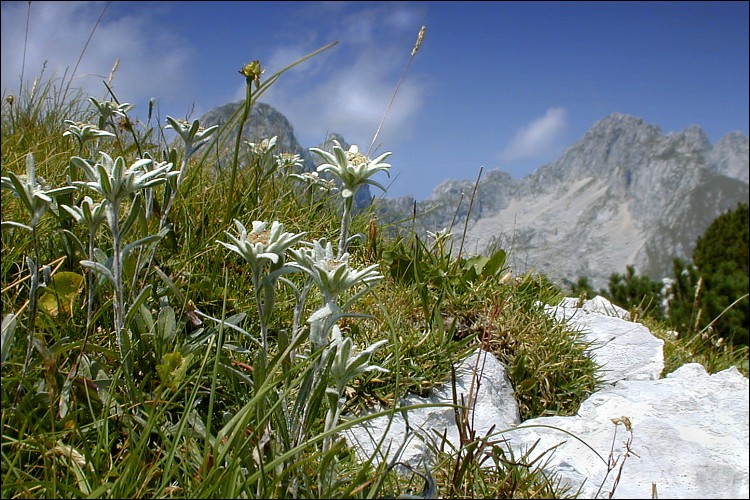Habitat
What type of habitat does
Edelweiss inhabit?
The beauty of the European mountain ranges such as the Alps,
Pyrenees Mountains, and the Italian Apennines is breathtaking. The
towering mountains and snowy peaks create an impressive and powerful
scene. Scattered upon the high slopes, however, there lies another
beauty: the Edelweiss plant, or Leontipodium alpinum. This
unique environment of high altitude and rugged terrain creates a
challenge for most plants to survive, but Edelweiss finds a way to
thrive in this distinctive habitat.
The first thing that distinguishes the habitat of
Leontopodium alpinum from that of most plants is the high
altitude at which it grows. Edelweiss lives at an elevation between
1800 to 3400 meters above sea level (Daniela et al. 2012). This
high-altitude requirement makes the mountain ranges of Europe a
perfect place for this plant to reside. The fact that the plant can
survive at such a high altitude made it very intriguing to those who
live near it. In many countries where Edelweiss resides, the plant
is a cultural symbol and an important part of their heritage. Used
in medicines, Edelweiss has been important to many European cultures
for centuries as an anti-inflammatory or an anti-microbial treatment
(Daniela et al. 2012). Aside from being used in medicines, the
Edelweiss plant is the national plant of the country of Switzerland,
and is even used on some forms of European currency (Dweck 2004).
The high-altitude can cause problems for most plants. Ultraviolet (UV) radiation levels are increased with higher elevation, because of a thinner atmosphere. Because of this, more UV rays reach the earth without being filtered out by the atmosphere. With every 1000 meters, UV radiation increases 12-16% (Kertesz et al 2005). High UV levels can be dangerous to all organisms, but this particular plant has means of using the radiation for its own benefit (See Adaptation).
Other unique factors of Edelweiss’s habitat, due
to the elevation, are low atmospheric pressure, extremes in
temperature and humidity, and rocky terrain (Dweck 2004). Low
atmospheric pressure makes it harder for plants to absorb CO2
(Kertesz et al. 2005). Temperatures in the European Alps at
this altitude can vary from season to season with extremes as low as
-20 degrees Celsius in the winter, and up to 32 degrees Celsius in
the summer (Dweck 2004). The rugged and rocky terrain of European
mountain ranges produces even more challenges for plant life:
shallow soil, poor nutrient levels, and large amounts of runoff from
melting snow.

The Alps and other mountain ranges of Europe have a unique
diversity of organisms that share the slopes with Leontopodium
alpinum. Other wild flowers such as the alpine carnation, alpine
rose, and gentian are all found in this habitat, as well as stags,
reindeer,
rabbit, and
fox, among other animals. These organisms, like
Edelweiss, have adapted to survive the high altitude and the
difficulties that come with it.
The habitat that Leontopodium Alpinum
lives in creates a very unique living situation. With the high
altitude comes low atmospheric pressure, higher ultraviolet
radiation, and extremes in temperature and humidity. However,
Edelweiss has adapted to not only survive, but even thrive with
these challenges in place.
Please see the References page to learn more about where we did our research on Edelweiss